Spring Cloud Saga provides a declarative way to coordinate distributed transactions, simplifying the implementation process: Add Maven dependency: spring-cloud-starter-saga. Create a Saga Orchestrator (@SagaOrchestration). Write participants to implement SagaExecution to execute business logic and compensation logic (@SagaStep). Define state transitions and actors in the Saga. By using Spring Cloud Saga, atomicity between different microservice operations is ensured.

How to implement distributed transactions in Spring Cloud Saga
Distributed transactions are essential to ensure the integrity of data between different microservices Sex is crucial. Spring Cloud Saga provides a declarative way to coordinate distributed transactions, simplifying the implementation process.
Dependencies
Add the following dependencies in the Maven project:
<dependency>
<groupId>org.springframework.cloud</groupId>
<artifactId>spring-cloud-starter-saga</artifactId>
<version>3.1.5</version>
</dependency>Create Saga
Saga is the coordinator of distributed transactions. To create a Saga, you need to create a class with the @SagaOrchestration annotation:
@SagaOrchestration
public class OrderSaga {
private final SomeService someService;
private final OtherService otherService;
public OrderSaga(SomeService someService, OtherService otherService) {
this.someService = someService;
this.otherService = otherService;
}
// 定义 Saga 的状态转换
// ...
}Writing Participant
The participant is the actual execution in the Saga Business logic components. They need to implement the SagaExecution interface:
public class SomeServiceImpl implements SagaExecution<OrderSaga> {
// 定义业务逻辑
// ...
}Practical case
Suppose we have an order system, which involves the following operations:
- Create order
- Deduct item quantity from inventory
- Send order confirmation email
We can use Spring Cloud Saga to coordinate these operations:
Order Saga
@SagaOrchestration
public class OrderSaga {
// 定义 Saga 的各个阶段
@SagaStep(output = "createOrder")
public void createOrder(SagaExecution<OrderSaga> sagaExecution) {
// 创建订单
}
@SagaStep(input = "createOrder", output = "decrementStock")
public void decrementStock(SagaExecution<OrderSaga> sagaExecution) {
// 从库存中扣除商品数量
}
@SagaStep(input = "decrementStock", output = "sendEmail")
public void sendEmail(SagaExecution<OrderSaga> sagaExecution) {
// 发送订单确认电子邮件
}
}Participant
public class OrderServiceImpl implements SagaExecution<OrderSaga> {
// 实现创建订单的逻辑
@Override
public void execute(OrderSaga saga, OrchestrationContext<OrderSaga> context) {
// ...
}
// 实现补偿逻辑
@Override
public void compensate(OrderSaga saga, OrchestrationContext<OrderSaga> context) {
// ...
}
}public class StockServiceImpl implements SagaExecution<OrderSaga> {
// 实现扣减库存的逻辑
@Override
public void execute(OrderSaga saga, OrchestrationContext<OrderSaga> context) {
// ...
}
// 实现补偿逻辑
@Override
public void compensate(OrderSaga saga, OrchestrationContext<OrderSaga> context) {
// ...
}
}public class EmailServiceImpl implements SagaExecution<OrderSaga> {
// 实现发送电子邮件的逻辑
@Override
public void execute(OrderSaga saga, OrchestrationContext<OrderSaga> context) {
// ...
}
// 发送电子邮件不需要补偿逻辑
@Override
public void compensate(OrderSaga saga, OrchestrationContext<OrderSaga> context) {
}
}By using Spring Cloud Saga, we implement distributed transactions and ensure Atomicity between order creation, inventory deduction and email sending.
The above is the detailed content of How to implement distributed transactions using Spring Cloud Saga. For more information, please follow other related articles on the PHP Chinese website!
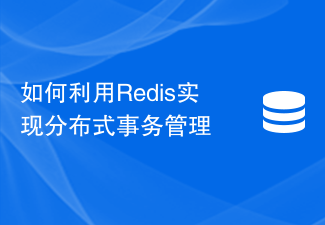 如何利用Redis实现分布式事务管理Nov 07, 2023 pm 12:07 PM
如何利用Redis实现分布式事务管理Nov 07, 2023 pm 12:07 PM如何利用Redis实现分布式事务管理引言:随着互联网的快速发展,分布式系统的使用越来越广泛。在分布式系统中,事务管理是一项重要的挑战。传统的事务管理方式在分布式系统中难以实现,并且效率低下。而利用Redis的特性,我们可以轻松地实现分布式事务管理,提高系统的性能和可靠性。一、Redis简介Redis是一种基于内存的数据存储系统,具有高效的读写性能和丰富的数据
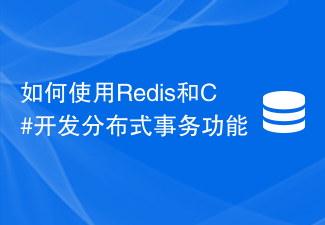 如何使用Redis和C#开发分布式事务功能Sep 21, 2023 pm 02:55 PM
如何使用Redis和C#开发分布式事务功能Sep 21, 2023 pm 02:55 PM如何使用Redis和C#开发分布式事务功能引言分布式系统的开发中,事务处理是一项非常重要的功能。事务处理能够保证在分布式系统中的一系列操作要么全部成功,要么全部回滚。Redis是一种高性能的键值存储数据库,而C#是一种广泛应用于开发分布式系统的编程语言。本文将介绍如何使用Redis和C#来实现分布式事务功能,并提供具体代码示例。I.Redis事务Redis
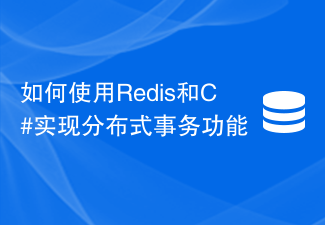 如何使用Redis和C#实现分布式事务功能Jul 29, 2023 am 11:05 AM
如何使用Redis和C#实现分布式事务功能Jul 29, 2023 am 11:05 AM如何使用Redis和C#实现分布式事务功能引言:随着互联网的迅猛发展和用户规模的不断扩大,分布式系统架构已成为一种常见的解决方案。分布式系统的关键问题之一是保证数据一致性,尤其是在涉及多个数据库的跨数据库事务处理中。Redis是一种高效的内存数据库,提供了用于实现分布式事务的特性,可以与C#语言结合使用来构建分布式系统。本文将介绍如何通过使用Redis和C#
 C#开发中如何处理分布式事务和消息队列Oct 09, 2023 am 11:36 AM
C#开发中如何处理分布式事务和消息队列Oct 09, 2023 am 11:36 AMC#开发中如何处理分布式事务和消息队列引言:在今天的分布式系统中,事务和消息队列是非常重要的组件。在处理数据一致性和系统解耦方面,分布式事务和消息队列起着至关重要的作用。本文将介绍如何在C#开发中处理分布式事务和消息队列,并给出具体的代码示例。一、分布式事务分布式事务是指跨多个数据库或服务的事务。在分布式系统中,如何保证数据的一致性成为一大挑战。下面介绍两种
 Redis实现分布式事务的负载均衡与容量规划Jun 20, 2023 am 09:06 AM
Redis实现分布式事务的负载均衡与容量规划Jun 20, 2023 am 09:06 AMRedis是一款开源的内存高速缓存数据库,拥有高并发、高性能的特点,在分布式系统中得到了广泛的应用。其中,Redis的分布式事务功能是其最受欢迎的特性之一,可以实现多个Redis集群之间的数据同步和负载均衡。本文将介绍Redis实现分布式事务的负载均衡与容量规划。一、Redis分布式事务在Redis中,分布式事务指的是将多个命令作为一个整体进行执行,其中任何
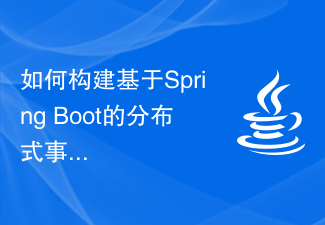 如何构建基于Spring Boot的分布式事务处理Jun 23, 2023 am 09:24 AM
如何构建基于Spring Boot的分布式事务处理Jun 23, 2023 am 09:24 AM在企业级应用程序中,分布式系统已经成为一个常见的架构模型。分布式系统由多个处理单元(节点)组成,这些节点协同工作以完成复杂的任务。在分布式系统中,事务处理是一个必不可少的组件,因为它能够确保所有节点协同工作的结果一致性。本文将介绍如何构建基于SpringBoot的分布式事务处理。一、什么是分布式事务处理?在单节点系统中,事务处理通常是一个简单的过程。当应用
 Gin框架的分布式锁和分布式事务详解Jun 22, 2023 am 09:14 AM
Gin框架的分布式锁和分布式事务详解Jun 22, 2023 am 09:14 AM随着互联网应用的不断开发和迭代,分布式架构越来越成为了主流的开发模式。在分布式系统中,分布式锁和分布式事务是两个非常重要的概念,它们可以有效地提高系统的并发性能和数据一致性。而Gin框架作为一个高性能的Web框架,也提供了一些非常好用的分布式锁和分布式事务的解决方案。一、Gin框架的基础知识Gin框架是一个以速度和性能为主要设计目标的Web框架,它基于Gol
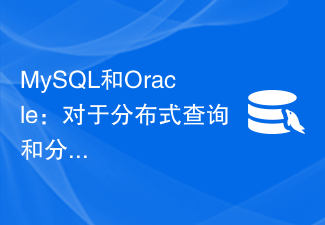 MySQL和Oracle:对于分布式查询和分布式事务的支持对比Jul 12, 2023 pm 10:39 PM
MySQL和Oracle:对于分布式查询和分布式事务的支持对比Jul 12, 2023 pm 10:39 PMMySQL和Oracle:对于分布式查询和分布式事务的支持对比引言:随着互联网和大数据时代的到来,企业的数据库系统变得越来越庞大和复杂。在这种情况下,分布式数据库管理系统(DistributedDatabaseManagementSystem)成为了一种必要的选择。MySQL和Oracle作为两种主流的数据库系统,在分布式查询和分布式事务的支持上有不同


Hot AI Tools

Undresser.AI Undress
AI-powered app for creating realistic nude photos

AI Clothes Remover
Online AI tool for removing clothes from photos.

Undress AI Tool
Undress images for free

Clothoff.io
AI clothes remover

AI Hentai Generator
Generate AI Hentai for free.

Hot Article

Hot Tools

SAP NetWeaver Server Adapter for Eclipse
Integrate Eclipse with SAP NetWeaver application server.

Dreamweaver Mac version
Visual web development tools

ZendStudio 13.5.1 Mac
Powerful PHP integrated development environment

Atom editor mac version download
The most popular open source editor

SublimeText3 Linux new version
SublimeText3 Linux latest version






